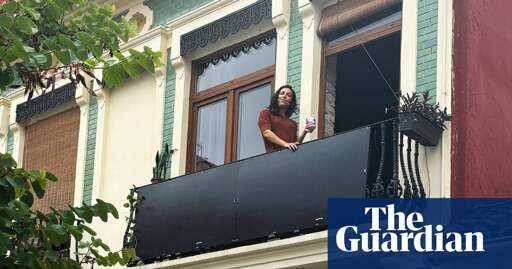It’s going to be hard to justify production costs, but in places that subsidize it: it makes perfect sense to scale up solar wherever possible.
That’s 4’ 11" - I had no idea Germans were so short.
i mean, it’ll work. You should probably just collectively work together to install a solar array on the roof of the apartment instead, assuming it doesn’t already have one.
Granted this is in the EU, so ideal solar tracking is kinda just, fucked. It matters more closer to the equator, because you can get significantly more power from pointing them correctly, and tracking, if you decide to use that.
any form of collective project requires organization, which conveniently is not required for an individual project that can be as impulsive and unsafe as the individual wants.
This is great for people who live in the middling latitudes.
Read it as germans who are 1.5 meter tall, wondered why them being short is relevant.
My dumb ass: “Is it just 1.5m Germans, or other heights too?”
M in million should always be capitalised for this reason.
1.5M Germans vs 1.5m Germans
Megagermans vs milligermans
This me me lol. Thank you 😂
Megagermans just sound evil.
And milligermans, well there’s a vaccine against that I think.
1.5 10^6 Germans vs 1.5 10^-3 Germans
Until I read this comment I was 100% certain the post was about short Germans somehow preferring having their balconies occluded by taller-than-them solar panels.
1.5m Germans are 150cm people !
Home solar indicates a massive management failure of public utilities. If it is more cost effective and more pleasant to generate your own electricity without any economies of scale, something is very wrong.
Source: I live in California where the “public” utility is an absolute disaster that charges $.60-$.70/kW/hr so anybody who can afford the upfront cost of solar has done so.
Microgeneration makes way more sense to me. If you generate the power where it is used without pollution, we should. The unfortunate piece is we have to many landlords who’s interest are too divorced from their tenets to put up more microgeneration
If you generate the power where it is used without pollution, we should.
Generators take space, require maintenance, and have a certain optimal capacity that isn’t necessarily hit on a given roof.
For wind energy in particular, the bigger the turbine, the more yield per $ spent. If you go out to Corpus Christi you’ll see these enormous turbines - $10M to $50M / ea - that generate on the order of $24 to $75 per MWh, or $.024-.075/kWh. Home wind/solar don’t get anywhere close to that.
Prime placement of units, distribution across a wide area, and a degree of storage capacity means you’re going to get better and more consistent yield.
welcome to the land of windmills
These microinverters aren’t made of fairy dust. Doing this stuff at utility scale uses a lot less nasty minerals and chemicals.
a mix of both is good, there’s arguments for doing local co-generation. Where you essentially turn a community into it’s own power plant, and when you’re talking about things like micro inverters, the cost doesnt really change.
Is it more efficient to do it at a utility grid scale? Yes, does that make it overall better? Not really, you still have to deal with grid inefficiencies, and maintenance, and well, you still have to deal with installations, so the cost isn’t that significant at the end of the day.
Solar is one of very few renewable energy sources that you can actually locally build and maintain on a small scale, no sense in removing that utility from it, that’s part of the reason it’s so popular.
Transformers, power lines, roads, trucks, and maintenance teams to move from large scale plants to houses also doesn’t grow on trees, but if maintenance in remote places doesn’t happen it can burn a lot of them.
Sometimes large scale plants make sense, but as the back up too microgeneration where the costs of infrastructure to move from unpopulated to populus areas make sense.
I am also a fan of less inverted power in microgeneration though. More and more of power usage is DC anyways. The need to convert to AC as much IMHO, but that is my far more radical take
microgeneration purely in DC only really makes sense in stuff like campers and RV’s where you’re going to be using primarily nearby, low power consumption devices.
AC is still better, plus modern switching technology while still fairly expensive, is considerably more efficient now. If you’re doing AC you also get a number of other benefits, notably, literally every existing appliance and device uses and works with AC voltages, the entire standard around electricity and home wiring is based on AC mains, all of the accessible hardware is also produced for AC mains, not that you can’t use it for something else, it’s just not intended for that.
Certain appliances will use induction motors, and similar other tech (clocks for example, often use the frequency of the power grid to keep time) based directly on the AC sinewave. You could still run them on DC, it’s just significantly sillier. Plus transmission efficiency is a BIG loss in DC (even now with modern solid state switching components, it’s still just, not ideal), granted thats less of a problem on a micro grid scale, it’s still a concern and potential restriction, nothing beats the simplicity and reliability of a simple wire wound iron core transformer. There are a handful of other technical benefits, and drawbacks as well, but fairly minor.
Having a dedicated DC supply side might be nice for a home environment, but the question is what do you standardize on? DC/DC voltage conversion is fairly efficient as it is already. Converting from AC/DC is incredibly easy and not particularly inefficient at lower power consumption, it’s more of a problem with higher draw devices. But you can easily get around that by using a higher voltage to convert down from.
Agreed. I maybe a radical DC home evangelist but yeah AC has its place still and it being THE standard for home appliances is a good example of the powers of scale.
So far for my home usage I’m standardizing on 48vdc because that is the last multiple of 12 before you go above OSHAs low voltage regs.
From there I really want to standardize further on the power delivery spec, because I just love the idea of smart grid for my home. I can then have dispered batteries in my home for either the primary benefits of that device is portable but doesn’t always need to be (laptop, power tool batteries, little robot thing, car, etc) or as a way to reduce some crazy limited time power draw (like servers starting up, oven running for an hour a day, etc).
From there maybe just Microadapter for a few standard circuits so the outlets work the same.
Makes sense mathematically or you think makes sense?
Both.
The reduction of infrastructure and leveraging existing buildings without reducing their existing utility vs converting a new space to be a dedicated power plant plus the infrastructure to move power from less populus (normal case because the cost of populus land is high due to demand) to more populus space.
I also idealogically support it because it makes more controllable by people and less controlled by an outside entity (a corporation/state).
Shoot, my electric is like $.0625/KWH
But there is also another 75-100 bucks tacked on as fees. Tempting to go solar and disconnect from the grid. Even without selling energy back to the grid, I would break even. (Savings over 20 years ~200 bucks)
God, I love living in a nuclear plant evacuation zone
it’s not actually that bad, unless you live next to a gen 1, or maybe gen 2 plant. Unless you’re next to one of like, three existing operational RBMK plants.
By the time you needed to evacuate from that area due to a nuclear disaster, you would be well informed, and probably gone already. Even if you didn’t the radiation exposure is likely to be incredibly minimal. Probably under the regulated limits.
The rent seekers making everything worse again
I live in an area where there is a monopoly of power supply by one of the worse polluters in American history, in a small area within a county there’s an existing co-op power company that was basically grandfathered in because it’s been in existence for so long while no other competitors are allowed in the area.
That co-op when I lived in the area was about half the cost of the monopoly company, a relative gets actually paid to be a member because they received their fathers account when he passed away and extra funds are distributed among all the members based on how long they’ve been with them (a little weird, but at least better than shareholders getting the profit).
You are absolutely right that the electric companies as a whole have failed, they’ve been allowed to amass too much influence and coverage while squashing any kind of competition. Why electrical needs aren’t considered a national resource is mind baffling to me. Our country and citizens way of life would literally grind to a halt without it.
Infrastructure should be public, with regulated access for wholesale and retail. It works. The grid operator needs to make money for large scale projects like interconnectors, modernising, maintenance and build.
This is really nice! This is the future!
I’d love to know how much they produce, especially during the winter/monthly.
not very much, especially during the winter, the best way to optimize panel production is by pointing it towards the sun most effectively, the farther north, or south, of the equator the less effective it is, the less directly it points towards the sun in general, the less power you make.
It might still produce a decent amount of power overall, through a reasonable period of time, but it’s probably WELL below what you could be making with an optimized install, especially one with solar tracking, granted some solar power is still better than no solar power, so you do get tradeoffs at the end of the day.
as another commenter said, there are solar power calculators out there, if you’re looking for rough figures, use them.
That kind of depends on what you’re building. Standard is currently 800W (2 standard solar panels). Older models use 600W, other models are using 2000W and limit it to 800W. That doesn’t make much sense, but skirts our local regulations that limits them to 800W, but of course generates more energy.
It then also depends on where you live. Can you point it to the sun? Do you live in sunny Spain or in northern Norway? In Germany a 800W system can produce 800-1200kWh per year. Our average electricity price is at 0.35€, so you’ll save 280€-420€ a year. And those systems are dirt cheap, there are deals out there where you can get one for 200€. That is quite a good ROI for something that you can install in an hour.
If you want to know more, here is a calculator https://priwatt.de/service/ertragsrechner/
Yeah I get all that, but what if I need heating in the winter and have very low consumption in the summer? That is why I’m searching for real world numbers. If you give me some for a specific place then I can at least have a ballpark number if what I might get where I live.
OTOH as you say, they start to be so cheap it’s almost impossible to go wrong…
That won’t really work as that is the worst scenario for solar. I can give you real world data from southern germany. I don’t have balcony solar, but a 13,4kWp solar system on my roof. Here is the data from this year:


As you can see, days are getting longer in Feb, generation is going up. To get a rough estimate, take my data and divide it by 16,75. That won’t give you a lot of heating, esp. with a normal space heater. Even if you had a scenario, where your 800W solar system would produce 800W in the winter, your space heater will suck 2000W. Take a look at its power cord, you’ll see how much it uses.
So yeah, 800W is not much, but will cover your running appliances like your fridge, freezer, router or computer on sunny days.
Hey thank you! I’m definitely saving this off for my future calculations!
You’re totally correct about the rest, and I’m now able to roughly see if I should buy a 800 system or two, or theee… Electric hookups included in the calculation of course.
In the Northern hemisphere, in Winter the Sun is at a low angle, so vertically oriented panels might produce more. As an example, I have a sunroom and at Winter’s Solstice the sunlight reaches about 3-4 meters into the room. At Summer’s Solstice there is no direct sunlight in the room, as the Sun is overhead.
couple of things to note:
- Not every balcony is southern facing
- Most older European homes don’t have A/C yet, so electrical costs are more during the winter months (that trend will change though I imagine)
- I think the numbers @[email protected] was asking about involved power output, that of course depends on the size of your array, daily/monthly/yearly differences in weather, and all sorts of little nuances that’s hard to say without averaging out years worth of data.
Do you have any numbers :-) ?
I have a sunroom, what sort of numbers are you asking for? It’s a partly cloudy day, about 22C in the room, without heat. And about 7C outside.
Nice numbers <3
For first few seconds, I deadass though they are talking about Germans with a height of 1,5 meters.
Only Germans this high have balcony solar
Makes sense, taller Germans throw too much of a shadow to make the solar worth it.
That was me.
So why won’t taller Germans get solar? I don’t even see the connection to height… Oh, maybe they hit their heads on the panels? No, that doesn’t seem likely… I don’t get it.
“Plug-in solar is part of the whole array of options,”
I don’t understand how this works? For our system we need an inverter that cost about $3000.- (half if it doesn’t have to handle a battery), and it needs to be installed by an authorized electrician.
For a small system as the one shown, the price of panels are peanuts, the 2 panels shown should cost less than $150 combined. While the cost of inverter and getting it connected is way way higher. There’s a lot more to this than not being on the roof!?! But which isn’t disclosed.The article says nothing about how the power from those panels is made usable.
Balcony solar is a set of diy technologies that require no utility permissions.
In Germany, NL, you can just plug it into socket and it works somehow.
In us you can use powerstations and also adapters that sync draw from battery as it charges from ac in house.
It pays for itself even with more expensive equipment, by not needed license, permission, that can lead to cheap efficient panels costing over 3$ per watt. Small systems that just offset use instead of selling back, have higher revenue offsets in high per kwh priced markets.
In Germany, NL, you can just plug it into socket and it works somehow.
This is incredibly dangerous as it will feed power into the grid even when the grid is down. You might say ‘that is great!’, yeah, well, the line technicians who cannot work on damaged cables because you are energizing them think otherwise.
One of the reasons home solar grid-feeding systems are expensive in the US is they have extra equipment to disconnect the system from the grid if the grid goes down. Your house can still have local power, but you won’t be energizing powerlines technicians are trying to fix.
These plugin systems shut down automatically when there’s a power outage. To make sure that they really do shut down when needed, in Belgium only plugin systems that have been approved by the network management organisation may be used. The other countries that allow these probably have similar precautions.
The “balcony” bit isn’t the defining characteristic, it shouldn’t be taken literally. Some people do have their “balcony solar power” on their roofs.
What defines it is limitation to 800 W and inverters that come with a normal Euro Type F (“Schuko”) plug and no legal requirement for professional installation. A layman can literally plug it in to an existing wall socket. Given that they are capped at 800 Watts, the inverters are also the simplest type and dirt cheap (although often they are literally just software-capped and identical to higher power ones, make of that what you will). Complete systems (2 panels, cabling, inverter) cost between 299€ and 800€ depending on quality. You genuinely only have to buy a fixture that suits your needs and a mate to help you install it.
Proper several-Kilowatt-systems are very expensive in Germany too.
Thanks really good info. 👍😀
A layman can literally plug it in to an existing wall socket
That’s amazing, I had no idea that is possible??? Is that special for Germany? (sorry for keeping on with new questions). 😋 I’ve never heard of that option here in Denmark.
cost between 299€ and 800€
No wonder it’s a popular option, our system is of course bigger with 11.2 kWh and 7.5 kWh battery. but it was $17000 1½ year ago. Prices have dropped to $12500 for a similar system, but still such an 800W system is dirt cheap by comparison.
I had no idea that is possible??? Is that special for Germany?
I mean, the regulation seems to be, but there’s no fancy tech going on. I’m not an electrician but I think I can explain, as I have recently tried to understand myself. To understand why it’s possible it’s best to understand why the limit is at 800 W precisely.
So German wall outlets usually have a 16 A fuse and the wiring in the walls is dimensioned to accommodate slightly higher current (I think they are 2.5mm² gauge allowing up to 20 A but don’t quote me on that particular part) for safety reasons. I suppose it would be the same or very similar in Denmark, or maybe most of Europe that uses 230V/50Hz AC.
Now, normally, if you have dangerously powerful load that would melt your wires, let’s say 5 kW, and you plug it in to an outlet the fuse will just pop and you’re safe. If however you have a 2 kW PV system connected to a wall outlet nearby, it would theoretically be possible that your 5 kW load draws 13 A (3 kW) from the mains through the fuse and another 8.7 A (2 kW) from the PV system over the same wire in the wall that is only rated at 20 A but now carries 21.7 A. And the fuse would never pop at 13 A, making it a huge fire hazard. 800 W is basically just what will always comfortably fit into the safety margin of the wiring in German houses. All systems above 800 W need to be hardwired by professionals “behind” the fuse box so that every Amp from your PV goes through a typical 16 A fuse.
still such an 800W system is dirt cheap by comparison
Absolutely. I guess the low threshold for installation allows some kind of mass market economy of scale whereas systems like yours are homeowners’ luxury goods.
Great post! Thanks for doing the math and explaining the concepts!
There are already a few requirements for operating the balcony panels, At least here in Germany:
- You need a suitable electricity meter
- You have to register with a relevant authority and inform the electricity provider that you are operating a “balcony power plant”.
- The microconverter should run on its own secured circuit. (“Should”, will certainly do very few) But technically it is simple:
- Set up panels
- Connecting necessary plugs
- Microconverter to the socket
- Be happy that you produce up to 800 watts of your own electricity
I think it’s almost irrelevant how many panels you ultimately split up. However, no more than 800 watts may be fed in.But if you have panels with, let’s say, 2000 watts, you can of course charge various batteries with them beforehand. Nobody can say anything against it.
Just for your information : belgium is allowing the balcony solar panels this year, but they have put limits on which you can install. The power supplier needs to have approved the kit you install. This is just to prevent people from getting cheap crap from the internet.
Other than that, same rules!Wait really? I didn’t know we finally caught up with the neighbors!
Officially it’s allowed after April 17th, but there’s already an extensive list of approved devices.
https://www.test-aankoop.be/woning-energie/hernieuwbare-energie/nieuws/plug-and-play-zonnepaneel
There’s probably a french version of that article as well, but test- achats/aankoop hasn’t made it easy to switch languages :)
You need a suitable electricity meter
That makes sense, we also needed new meter, and that was about €200.- with installation. Not a big deal for a big installation, but for a system that can cost only €300.- an extra 200.- would be pretty significant.
There are two main inverter approaches. One big inverter that takes the DC from a bunch of panels and converts it into AC and micro inverters where each panel gets it’s own small one placed directly under the panel.
The micro inverters cost around $150 each. So you need around 10 panels before the single inverter becomes a good choice.
Installers love the micro because the install is easier. However as a owner with say 30 panels you now have 30 points of possible failure instead of the 1.
Oh boy, apparently there’s a lot I don’t know. It’s really cool there are those cheaper options now.
Have a look here: https://en.m.wikipedia.org/wiki/Balcony_solar_power
OK thanks, so they are indeed complete systems including inverter, so it can be connected to the grid.
I suppose they’ve made some cheap low power inverters then, but the power still needs to have stable voltage an frequency and synchronization. So I wonder how cheap it’s possible to make?
I also suppose it still needs an authorized electrician to connect it? Unless Germany has some fancy system that is prepared for “plug in” connection of a local power source.In the EU, as long as it’s under 800W it can be plugged directly into an outlet in your home without any kind of installation, back-feeding the grid that way.
You’re not getting paid anything for the power you send back into the grid so anything you don’t use you lose.
Still very cool, because selling surplus power is almost completely worthless anyway. (at least it is here)
In the summer when you can sell, prices are generally extremely low, we have sold about twice what we use, but the value of selling is only about 5-10% on average, compared to the savings of using it ourselves. That’s because the price often drop to close to zero in the middle of the day, and sometimes even below.
Electricity itself is dirt cheap, the reason the prices are high are transportation and taxes, and short peak prices in the evening. Here transportation alone is more than the electricity itself during winter.
And we are only paid the pure electricity price here, which I suppose is the case most places.
It literally plugs into the wall.
That’s amazing. 😀
If you pay 3000€ for an inverter then that’s probably included installing and whatnot. You can get a cheap 50€ 4kW inverter on aliexpress, or an expensive 500€ 10kW one.
No the price was not including installation, We have 11.2 kW panels and 7.5 kWh batteries. Installation was almost $5000.- !! That was probably mostly the 28 panels on the roof. But we had one installer handling everything, who was also responsible for the electrician.
That’s a massive installation though! Wow!
Also, you got a biig roof!
When we bought the house, that was one of the parameters on our list for “the perfect house”. So the roof to the garden is also almost perfectly towards the south. 😀
Even in January we’ve made 41% of our power consumption from the solar panels. 😎 You are right that it is a bit oversized according to “normal” recommendations which are 8 kWh for a house the size of ours, but we went a bit bigger in preparation for air to water heat pump, so warming the house will be electric, (currently wood pellets), and also we plan to buy an electric car within the next 2 years.Also it was a bit for fun, because of the movie spinal tap, so our panels go to 11 instead of just 10, because we need that little bit extra. 😋
Smart planning! Thanks for the story, are you planning to go off grid or is it just to be economically free? Any batteries in the future? Excellent reference, and implementation, I’m giving you an 11 out of ten!
Thanks. 😀
Going off grid was absolutely a consideration, but only for a very short while. There are too many downsides. We would need twice as much solar capacity, and a way bigger battery, and batteries are still pretty expensive, but even with that, we would still need a generator. And we wouldn’t be able to sell surplus energy. It would more than double the cost, and only provide 25% better self sufficiency for the whole year than we have now.
We live in Denmark, and we can risk to have to go through almost all of December with only a few days sun. Running a diesel generator for power would be both noisy and smelly, It would also require more work to maintain, and it would actually cost slightly more to us a generator than to simply buy the electricity from the grid.Remember doubling our capacity will not bring us from 41 to 82% self sufficiency. Because there is some loss in storage, and even double our battery capacity would not be enough to store 48 kWh like we made today in the span of only 7 hours. (Today was the best day of the year yet. 😎)
Even in January on a perfect day, we can make twice what we use, but such days are rare in January. (we use about 15 kWh per day.)The final problem with a generator is that we would never be able to achieve remotely the stability we have with the grid. We’ve been living here for 6½ year, and the power has only been out once!!!
The problem with making it bigger than we have at all, is that after you’ve reached a point of above 50% self sufficiency, you are entering the area of diminishing returns quickly. On a yearly basis we are about 72% self sufficient. To reach that extra 22% probably cost 50% extra.
This is if you live as high north as we do, because the extra capacity is only usable in the winter, in the summer it’s all surplus, and you get so little for selling the power it’s basically irrelevant. There is too much solar now, so when solar panels have high yields, prices often go down to almost zero.
Going off grid is a lot easier if you live further south.
I wonder if a whole building could use one or two inverters?
I feel that’ll make the cost reasonable
For apartment buildings I don’t think that’s possible, since electricity is a per household connection with separate meter.
In b4 nimbys complain it’s an eyesore despite most people never looking up
Usually not uglier than the balcony itself.
Wait that’s a thing?
Holy shit that a thing!? That’s awesome!!
The relentless march of sustainable cosplay continues. A million Germans clinging to plasticky solar trinkets like rosary beads against energy insecurity—how very on-brand for a nation that dismantled nuclear plants to cozy up with Putin’s pipelines. Nothing screams “green revolution” like propping up coal while bureaucrats hyperventilate over balcony wattage permits.
But sure, let’s pretend these glorified battery chargers absolve collective guilt. Social media’s latest performative ritual—slap a panel on your railing, flood Instagram with hashtags, ignore the 14-month waiting list for certified installers. Peak late-stage decarbonization theater: all aesthetics, no grid.
At least it’s honest. We’ve stopped pretending policy can fix anything. Why demand competent governance when you can DIY your dystopia?
how very on-brand for a nation that dismantled nuclear plants to cozy up with Putin’s pipelines.
classic german meme, to be fair, they do actually have some pretty decent renewable production, they just really shot themselves in the foot while hiking up a mountain with that move.
Germany’s energy transition is a masterclass in contradictions. Dismantling nuclear plants—clean, reliable, and efficient—only to lean on Russian gas and coal is not just shortsighted but self-sabotaging. The Energiewende, while ambitious, has exposed Germany to geopolitical vulnerabilities and grid instability. Renewable expansion is commendable but insufficient without robust infrastructure and energy storage.
The reliance on balcony solar panels and rooftop systems reeks of performative sustainability. These micro-solutions barely scratch the surface of Germany’s energy needs yet are paraded as revolutionary. Meanwhile, bureaucratic inertia delays large-scale renewable projects.
The nuclear phase-out, driven by political expediency rather than pragmatism, left an energy vacuum filled by fossil fuels. A true green transition demands realism: embrace nuclear, bolster renewables, and stop romanticizing half-measures.
Are you under the impression that the people buying solar for themselves are against sustainable energy solutions on a state level?
Would be nice if grid tied inverters weren’t such a regulatory PITA. Micro-deployment solar, and more importantly distributed energy storage, makes so much sense and could solve a lot of grid-related problems.
I can tell you I have a portable solar battery for emergencies and if I need to use it the right place for the panel is in my balcony, so this makes a ton of sense. In an apartment building roof space is relatively small per unit, but at least where I am every unit has a balcony. In my case even a rear-facing balcony that doesn’t face the street but still gets sun for anywhere between 4-10 hours a day. If/when I am in a position to explore a solar installation this would be a good thing to look into.










